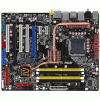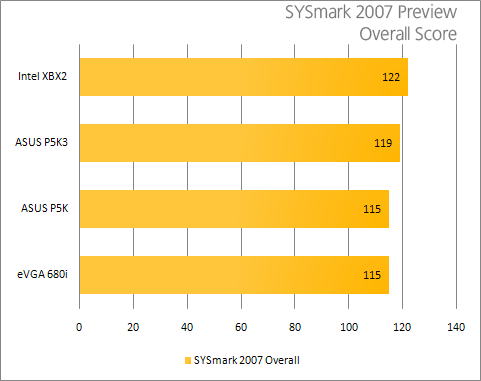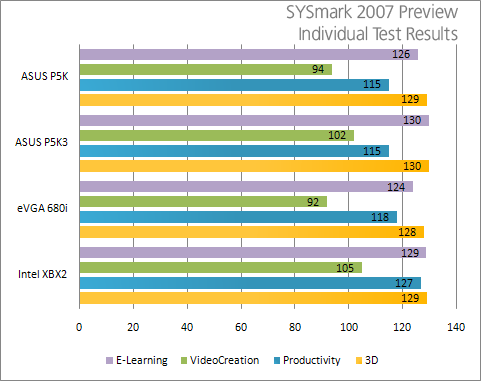- Qualcomm Launches Snapdragon 4 Gen 2 Mobile Platform
- AMD Launches Ryzen PRO 7000 Series Mobile & Desktop Platform
- Intel Launches Sleek Single-Slot Arc Pro A60 Workstation Graphics Card
- NVIDIA Announces Latest Ada Lovelace Additions: GeForce RTX 4060 Ti & RTX 4060
- Maxon Redshift With AMD Radeon GPU Rendering Support Now Available
ASUS P5K Deluxe WiFi-AP

With the launch of Intel’s P35 chipset, ASUS promptly released seven boards for you to choose from. A few weeks ago we had taken a look at the P5K3 and were left very impressed. Given the fact that the P5K is strikingly similar in specs, we hope to be left as equally impressed.
Page 4 – Testing Methodology, SYSmark 2007
|
|
Throughout all of our benchmarks regardless of what we are reviewing, testing is done in a clean and stand-alone version of Windows XP Professional with SP2. No Windows Updates are applied for the sake of efficiency, unless one is required for a piece of hardware on the computer. Prior to testing, these conditions are met:
- Desktop and scrap files are cleaned up, including emptying of recycle bin.
- No virus scanner or firewall is installed in the stand-alone installation.
- The stand-alone installation drive is completely defragged using Diskeeper 2007 Professional.
- All unnecessary programs are closed, so that Windows should have no more than 15 active processes running.
- Computer has proper airflow.
The testing rig used for todays benchmarking is as follows:
- CPU: Intel E6600 – 2.4GHz
- Motherboard: ASUS P5K Deluxe WiFi-AP
- Memory: OCZ 2GB NVIDIA PC2-7200 (For DDR2 Boards)
- Video: ASUS EN8800GTX 768MB
- Sound: Onboard HD Audio
- Storage: Seagate 7200.9 320GB
- Etcetera: Windows XP Professional SP2
- Cooling: Corsair Nautilus 500
For comparison purposes, we have pitted the P5K against the ASUS P5K3, which uses a P35 chipset, the eVGA 680i which uses a 680i SLI chipset and also the Intel XBX2, which uses the 975X chipset. The P5K3 is a DDR3 board, so it’s important to note that it wouldn’t be a surprise to see it dominate in the charts, thanks to it’s faster memory speed. We have included it because it’s still a relevant comparison. The memory speeds used are as follows:
- DDR2 memory is run at DDR2-800 speeds with 4-4-4-12-2T timings at 1.9v
- DDR3 memory is run at DDR3-1066 speeds with 6-6-6-15-2T timings at 1.6v
2T was used for the DDR2 settings because of the Intel XBX2’s inability to use 1T.
SYSmark is an industry leading system benchmarking tool, which is completely automated but utilizes real-world tests. It installs common applications such as Microsoft Word and Excel, Photoshop CS2, 3DS Max, SketchUp! among others.
SYSmark grades the performance of the system with various methods, but most notably how well it could handle different operations. Systems with more than one core will benefit in the tests, since there is a lot of multi-tasking throughout. Once the test is completed, it will provide you with an overall score, in addition to showing areas where the computer excelled.
The P5K matched up perfectly with the 680i, but the extra oomph from the DDR3 memory on the P5K3 helped it push ahead. Intel’s XBX2 blew past all of them, though.

The individual test results can give us a deeper look at where each board failed, or performed well. Regarding 3D tests, all of the motherboards performed quite well to one another. When performing personal renders with 3DS Max, I found that this was always the case.

Similar to the overall tests, the eVGA 680i and ASUS P5K matched up, while the XBX2 took the lead with the P5K3 trailing slightly behind.
|
|
Support our efforts! With ad revenue at an all-time low for written websites, we're relying more than ever on reader support to help us continue putting so much effort into this type of content. You can support us by becoming a Patron, or by using our Amazon shopping affiliate links listed through our articles. Thanks for your support!





